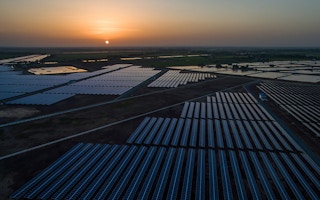The COVID-19 pandemic has profoundly impacted the global economy, including countries in the Association of Southeast Asian Nations (ASEAN). Virtually all the authorities in ASEAN launched fiscal stimulus packages throughout the pandemic to mitigate the negative impact of COVID-19.
On average, ASEAN member states have allocated around 7.7 per cent of their GDP for fiscal stimulus. This includes health and non-health spending (6.2 per cent when combined), and liquidity support (1.5 per cent).
COVID-19 fiscal stimulus is seen as an opportunity to shift the recovery trajectory towards a green and sustainable path. This is especially so as the size of economic packages launched by governments worldwide in just two months was already three times larger than the amount spent during the 2008 global financial crisis.
Hence, the UN Secretary-General regards this as a ‘rare and short window of opportunity’. Other international organisations, such as the World Bank and IMF, have also called for green fiscal stimulus to ensure that the recovery trajectory from the COVID-19 pandemic aligns with climate targets.
In a similar vein, many leaders in the private sector also advocate for a ‘green recovery’. The World Economic Forum, for instance, launched the Great Reset initiative, where one of the critical components is to ensure a greener world after the COVID-19 pandemic.
Nevertheless, current assessments suggest that the amount of COVID-19 stimulus directed for energy transition among the ASEAN member states is limited. The Global Recovery Observatory database shows that zero recovery spending is considered green in six countries — Indonesia, Malaysia, Philippines, Thailand, Singapore and Vietnam.
“
The Global Recovery Observatory database shows that zero recovery spending is considered green in six countries — Indonesia, Malaysia, Philippines, Thailand, Singapore and Vietnam.
On the contrary, some of the spendings may potentially harm the environment. These include incentives for airlines and other forms of transport without green conditions.
ASEAN has recognised the importance of a sustainable and resilient future in overcoming the pandemic by outlining implementation plans under its Comprehensive Recovery Framework. Several member states may have also launched unquantifiable programs for green recovery. However, the limited quantifiable stimulus for green recovery is alarming, suggesting that ASEAN might miss the one-time opportunity to build back better.
One crucial factor restraining ASEAN countries from allocating a substantial amount of fiscal stimulus for green recovery is structural problems, especially the limited budgetary capacity in developing countries. Countries with lower sovereign credit, higher sovereign bond spreads, and higher public debt found it more challenging to launch a substantial COVID-19 related fiscal spending.
ASEAN countries also experienced a vast fiscal disruption due to the COVID-19 pandemic. On average, the ratio of national governments’ revenues to GDP dropped by 1.09 percentage points. Countries faced more fiscal constraints and are forced to focus on pandemic control measures to help the most vulnerable households and firms in the hardest-hit sectors, such as tourism, transport, and small and medium-sized enterprises.
The situation would be more formidable in the medium term as ASEAN countries face widening fiscal deficits induced by the COVID-19 pandemic. Over the last year, member states’ budget deficit as a percentage of GDP worsened from -1.3 per cent in 2019 to -5.4 per cent.
As a result, debt also surged from 51.9 per cent of GDP in 2019 to 60.9 per cent. Many member states have outlined plans for fiscal consolidation to ensure sustainability in the long run. Without a recovery in tax revenue, the government has no choice but to pursue expenditure consolidation that could further limit the fiscal space to fund green transition projects.
At the same time, the ASEAN Plan of Action for Energy Cooperation 2021-2025 specifies a 23 per cent share of renewables in the total primary energy supply by 2025. This is to be achieved by increasing the share of renewables in installed power capacity by 35 per cent from 2005 levels, and reducing energy intensity by 32 per cent in the same period.
It is estimated that the ASEAN countries need to invest US$367 billion in the power sector to reach the aspirational targets. The limited fiscal space faced by member states during the pandemic can put this target at risk. In this case, it requires extra effort from governments in the region to cope with a limited fiscal budget while working on meeting their energy transition targets.
To achieve the twin targets of improving the fiscal situation post COVID-19 while realising the energy transition targets, governments should integrate a green perspective into budgetary consolidation efforts.
The options include:
- Leveraging private participation through green and sustainability bonds;
- Exercising global and regional funding from multilateral development partners and banks;
- Implementing carbon pricing.
Some countries have seen green bonds as one alternative to utilising private participation to achieve green recovery. In 2020, China’s green bonds market managed to achieve a new record of US$44 billion, or a 12 per cent increase compared to the previous year, despite the impact of COVID-19.
Secondly, multilateral development banks may play a role in fostering green recovery after the pandemic. One example is the ASEAN Catalytic Green Finance Facility (ACGF) Green Recovery Program, supported by the Asian Development Bank. It revolves around using the Green Climate Fund to help ASEAN countries rebound without environmental degradation while stimulating economic growth by creating green jobs.
Lastly, regulated carbon pricing will trigger more energy transition innovation in the private sector and lessen the burden on the fiscal space. Singapore, for example, has effectively adopted a Carbon Pricing Act since 2019 in its effort to transition to a low-carbon economy.
To mitigate possibly higher energy costs, Singapore utilises the tax revenue to provide incentives for lower-income households and investments for businesses that innovate in environmental, social, and governance initiatives.
ASEAN member states may consider focusing on improving the enabling environment for green recovery. These include establishing a clear and consistent policy framework, introducing incentives to increase clean energy investment, as well as enhancing institutional arrangements and effective coordination between relevant authorities. Adequate green fiscal policies will help ease the potential inflation from the transition away from fossil fuels and their volatile prices.
As the deadline for the climate targets is fast approaching, ASEAN countries cannot afford to miss another opportunity for green recovery from the pandemic. While fiscal disruption limits countries’ capacities to fund green projects, there is hope to turn things around.
As governments prepare for fiscal consolidation, it is crucial to integrate a green perspective into the plan. If a green budgetary consolidation is implemented, we can turn the crisis into an opportunity.
Rika Safrina is a technical officer in the Modelling, Policy, and Planning department at the Asean Centre for Energy, a Jakarta-based energy think tank.
Imaduddin Abdullah is a researcher at the Institute for Development of Economics and Finance in Indonesia.












